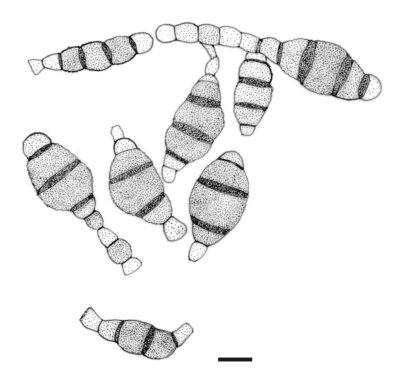Fungalpedia – Note 306, Simmonsiella
Simmonsiella J.L. Crane & A.N. Mill.
Citation when using this entry: Perera et al. 2024 (in prep) – Fungalpedia, genera described in 2016.
Index Fungorum, Facesoffungi, MycoBank, GenBank, Fig. 1
Classification: Incertae sedis, Incertae sedis, Incertae sedis, Incertae sedis, Pezizomycotina, Ascomycota, Fungi
Crane & Miller (2016) proposed the monotypic genus Simmonsiella to accommodate Torula ndjilensis based on an unique characteristic of the species: first-formed conidia that develop into a series of intercalary phragmoconidia. Hence, no sequence data are available for Simmonsiella ndjilensis, the genus have been maintained in Ascomycota Incertae sedis (Crane & Miller 2016). Simmonsiella is characterized by effuse, brown to grey-brown colonies, composed of branched, septate, hyphae with smooth or echinulate walls. Conidiogenous cells are discrete, borne terminally or laterally on the hyphae, thin-walled, subhyaline, subcylindric to obovate, monoblastic or polyblastic. Thick-walled phragmoconidia borne singly or in chains. They are light brown to dark brown and becoming darker with age, with black bands at the septa. The shragmoconidia have verrucose to echinulate walls. Catenate conidia may be formed by an apical cell of a conidium becoming conidiogenous. Apical cell blastically forms a conidium or more frequently, the apical cell of a conidium blastically forms a light brown. Those intercalary hypha in turn forms blastically a conidium. A chain of conidia separated by intercalary hyphae are generated by repeating this process. The sexual morph is undetermined (Crane & Miller 2016).
Type species: Simmonsiella ndjilensis (É. Kiffer) J.L. Crane & A.N. Mill.
Other accepted species: This genus is monotypic.
Figure 1 – Simmonsiella ndjilensis (ILLS 68272, holotype). Mature, solitary and catenate conidia. Scale bars: 10 μm. Redrawn from Crane & Miller (2016).
Reference
Entry by
Rekhani Hansika Perera, Center of Excellence in Fungal Research, Mae Fah Luang University, Chiang Rai, 57100, Thailand.
(Edited by Kevin D. Hyde, Samaneh Chaharmiri-Dokhaharani, & Achala R. Rathnayaka)
Published online 8 July 2024
